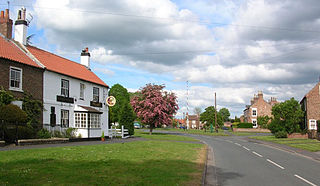
Upper Poppleton is a village and civil parish in the unitary authority of the City of York in North Yorkshire, England. It is situated by the west bank of the River Ouse adjacent to Nether Poppleton, and west of York close to the A59 from York to Harrogate. The village is served by Poppleton railway station on the Harrogate Line. According to the 2001 census, the parish had a population of 1,961, increasing to 1,997 at the 2011 Census. Before 1996, it was part of the Borough of Harrogate.

The Wharfedale line is one of the rail services in the West Yorkshire Metro area of northern England. The service connects Ilkley with Leeds and Bradford, and is operated by Northern Trains. West Yorkshire Metrocards are available for use on the line, covering Zones 3–5. The line is served predominantly by four-coach Class 333 electric multiple units as well as some three-coach Class 331 EMUs.
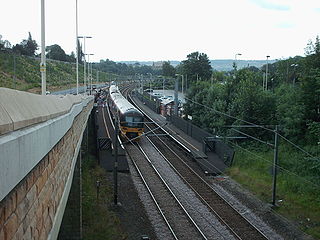
The Airedale line is one of the rail services in the West Yorkshire Metro area centred on West Yorkshire in northern England. The service is operated by Northern, on the route connecting Leeds and Bradford with Skipton. Some services along the line continue to Morecambe or Carlisle. The route covered by the service was historically part of the Midland Railway.

Northallerton railway station is on the East Coast Main Line serving the town of Northallerton in North Yorkshire, England. It is between Thirsk to the south and Darlington to the north. Its three-letter station code is NTR.
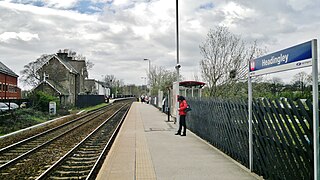
Headingley railway station is off Kirkstall Lane in Leeds, West Yorkshire, England, on the Harrogate Line, 3 miles (5 km) north west of Leeds. The station was opened in 1849 by the Leeds & Thirsk Railway, later part of the Leeds Northern Railway to Northallerton.

Horsforth railway station serves the town of Horsforth in West Yorkshire, England. It is a stop on the Harrogate Line, 5.75 miles (9 km) north-west of Leeds, and is the final stop in the West Yorkshire Metro regulated area towards Harrogate.
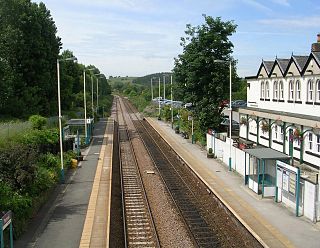
Pannal railway station serves the villages of Pannal and Spacey Houses in the southern suburbs of Harrogate, North Yorkshire, England, equidistant from both. It also serves the village of Burn Bridge, on the opposite side of Pannal. It is located on the Harrogate Line 15 miles (24 km) north of Leeds and operated by Northern who provide all passenger train services.
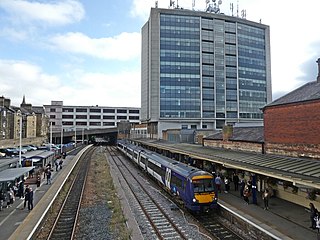
Harrogate railway station serves the town of Harrogate in North Yorkshire, England. Located on the Harrogate Line it is 18.25 miles (29 km) north of Leeds. Northern Trains operate the station and provide local passenger train services, with a London North Eastern Railway service to and from London King's Cross running six times per day.

Starbeck is a railway station on the Harrogate Line, which runs between Leeds and York via Harrogate. The station, situated 18+1⁄4 miles (29 km) west of York, serves the village of Starbeck, in North Yorkshire, England. It is owned by Network Rail and managed by Northern Trains.
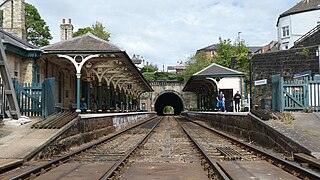
Knaresborough railway station is a Grade II listed station serving the town of Knaresborough in North Yorkshire, England. It is located on the Harrogate Line 16.75 miles (27 km) west of York and is operated by Northern Trains, who provide all passenger train services.

Hammerton is a railway station on the Harrogate Line, which runs between Leeds and York via Harrogate. The station, situated 8+3⁄4 miles (14 km) west of York, serves the villages of Green Hammerton and Kirk Hammerton, Borough of Harrogate in North Yorkshire, England. It is owned by Network Rail and managed by Northern Trains.
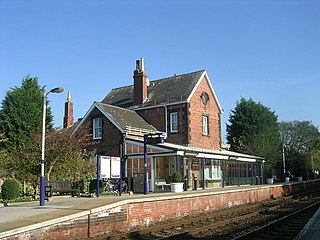
Poppleton is a railway station on the Harrogate Line, which runs between Leeds and York via Harrogate. The station, situated 2 miles 72 chains (4.7 km) west of York, serves the villages of Nether Poppleton and Upper Poppleton, City of York in North Yorkshire, England. It is owned by Network Rail and managed by Northern Trains.

The Leeds–Northallerton railway is a partly disused railway line between West and North Yorkshire, in northern England.

The 36 is a bus service operated by The Harrogate Bus Company, which links Leeds, Harewood and Harrogate with Ripley and Ripon. It is operated by a fleet of high-specification Wright Gemini 3 bodied Volvo B5TL double-deck vehicles, branded in a red and black livery.

Wetherby railway station was built on the North Eastern Railway's Cross Gates to Wetherby Line on Linton Road. It replaced an earlier station on York Road which had opened on 1 May 1876.

Ripon railway station was a railway station that served Ripon, North Yorkshire, England on the Leeds-Northallerton Line that ran between Harrogate and Northallerton.

The Leeds Northern Railway (LNR), originally the Leeds and Thirsk Railway, was an English railway company that built and opened a line from Leeds to Stockton via Harrogate and Thirsk. In 1845 the Leeds and Thirsk Railway received permission for a line from Leeds to Thirsk, part of which opened in 1848, but problems building the Bramhope Tunnel delayed trains operating into Leeds until 1849.
The East and West Yorkshire Junction Railway was a railway company established in 1846 between the Leeds and Thirsk Railway at Knaresborough and the York, Newcastle and Berwick Railway near York, England. The company merged into the York and North Midland Railway in 1852.
Leeds/Bradford Airport Parkway station is a proposed railway station near Horsforth, Leeds, in West Yorkshire. It would have around 300 parking spaces serving Leeds Bradford Airport along with adjoining areas including Cookridge, Bramhope and Yeadon and would be situated on the existing Leeds-Harrogate-York route north of the existing Horsforth station. The proposal uses both the existing dedicated airport car park bus services and the existing main line railway infrastructure with the new station thus enabling frequent direct access to Leeds, Harrogate, Knaresborough and York along with many other rail journeys using interchange at Leeds or York stations.
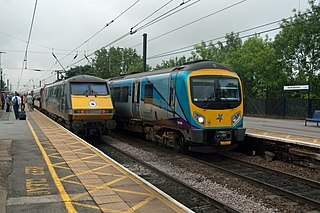
The network of railways in Northallerton, North Yorkshire, England, was constructed by three companies whose lines through the town were built between 1841 and 1852. They were all amalgamated into the North Eastern Railway (NER) which in turn was subsumed into the London and North Eastern Railway in 1923 and British Rail in 1948. British Rail closed two lines, the Wensleydale line in 1954 and a section of the Leeds Northern Railway to Harrogate in 1969. The Wensleydale line was retained as a freight branch and resurrected as a heritage railway in 2003 but the line to Harrogate closed completely. Despite closures and rationalisation, the station still is at a major junction on the East Coast Main Line.






















